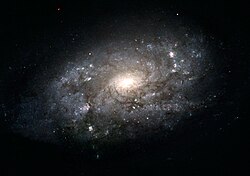NGC 3949
| Galaxy NGC 3949 |
|
|---|---|

|
|
| Photo from the Hubble Space Telescope | |
| AladinLite | |
| Constellation | Big Bear |
|
Position equinox : J2000.0 , epoch : J2000.0 |
|
| Right ascension | 11 h 53 m 41.7 s |
| declination | + 47 ° 51 ′ 31 ″ |
| Appearance | |
| Morphological type | SA (s) bc: / HII |
| Brightness (visual) | 10.6 mag |
| Brightness (B-band) | 11.4 mag |
| Angular expansion | 2.9 ′ × 1.7 ′ |
| Position angle | 120 ° |
| Surface brightness | 12.2 mag / arcmin² |
| Physical data | |
| Affiliation | M109 group (NGC 3992 group, LGG 258) |
| Redshift | 0.002669 ± 0.000004 |
| Radial velocity | 800 ± 1 km / s |
|
Stroke distance v rad / H 0 |
(38 ± 3) x 10 6 ly (11.7 ± 0.8) Mpc |
| diameter | 45,000 ly |
| history | |
| discovery | Wilhelm Herschel |
| Discovery date | February 5, 1788 |
| Catalog names | |
| NGC 3949 • UGC 6869 • PGC 37290 • CGCG 243-025 • MCG + 08-22-29 • IRAS 11510 + 4808 • 2MASX J11534174 + 4751316 • GC 2604 • H I 202 • h 1009 • Holm 301A | |
NGC 3949 is a spiral galaxy with extensive star formation from Hubble type SA (s) bc in the constellation Ursa Major, the estimated 38 million light-years from the Milky Way 's center. In NGC 3949 a supernova has been observed so far : SN 2000db .
The object was discovered on February 5, 1788 by the German-British astronomer Wilhelm Herschel .
Web links
- SIMBAD Astronomical Database
- Hubble Space Telescope
- astronews.com: View of a cousin of our Milky Way August 6, 2004
- The glow of the Milky Way
